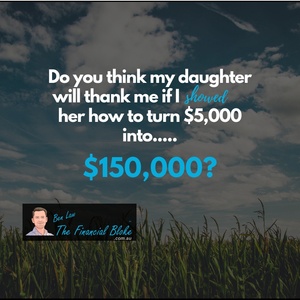Investing in your children, or grandchildren’s, future.
With the arrival of our daughter Sophie in June 2016, like all new dads, I suddenly had a whole new set of problems I needed to start thinking about. While the thought of her dating somewhere down the track is unsettling to say the least, being ‘The Financial Bloke’, her financial education and financial future is also never far from my thoughts.
As such, my wife ‘Mrs Financial Bloke’ and I are in the process of putting together a small investment portfolio for her, and crossing our fingers that ‘Little Miss Financial Bloke’ will inherit and learn some of my strong financial sense.
Personally, one of my favourite investment tools is compound interest, it’s one of the world’s most powerful investment ‘levers’ and was a no brainer when it came to organising a saving strategy for Sophie.
Compound interest is the eighth wonder of the world. He who understands it, earns it…he who doesn’t… pays it.
Albert Einstein
But what exactly is compound interest? And why is it such a powerful tool?
Compound interest Is, by definition, the addition of interest to the principal sum of a loan or deposit, or in other words, interest on interest. It is the result of reinvesting interest, rather than paying it out, so that interest in the next period is then earned on the principal sum plus previously accumulated interest.
As such, really small investments, compounded and regularly added to, have the potential to become significant investments. Sounds too easy doesn’t it? There are definitely a few provisos, such as ensuring that you:
- Have enough years to invest to get the full benefits of the compounding;
- Invest in quality, well diversified assets and have the discipline to stay invested; and
- Have the discipline to continue adding to the investment regularly.
In simple terms, let’s say we start with a $5,000 initial investment portfolio for Sophie. We add $200 per month to the investment and increase that $200 per month by 3 percent each year. This is called a Regular Savings Plan. I am assuming an investment return of 8 percent per annum.
From my calculations, I’d suggest that by the time Sophie turns 21, there should be around $150,000 invested.
That’s a pretty impressive portfolio for a 21 year old and a fantastic opportunity with which to start her adult life. It is important to note that I am not say just give her the money but rather to use it to educate her on how to be a successful investor, maybe put a deposit on her first home, pay for university or start her own business. It may even inspire some healthy financial habits - as opposed to spending all her money and giving Dad even more headaches!
This is the beauty of compounding interest.
But this is the beauty of compounding interest. As our children grow, so too does their investment.
So, are you or should you, be putting small amounts of money away for your children, grandchildren, or maybe even your future self? It’s something to think about, but don’t think for too long – when it comes to a long-term, compounding interest savings strategy, it pays to be proactive. The sooner you start, the better the results!
Enjoy your month and for now, I’m the Financial Bloke and I’m all about turning your Farming Success into Financial Freedom.
Cheers,

This article was first published in The Land.
Warning: Past performance is not indicative of future performance and any projections are for illustrative purposes only and in no way guaranteed to occur.

